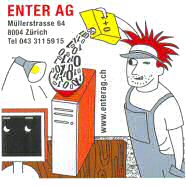Enter AG - platform Download
Platform (32/64) detection of Windows executables (DLL/EXE)
Platform Confusion with the JDBC-ODBC-Bridge
Table Of Contents
64-bit Windows Does not Imply 64-bit MS Office
32-bit ODBC Data Sources in 64-bit Windows
Installing 64-bit MS Office 2010
64-bit Windows Does Not Imply 64-bit JAVA
64-bit JNI Can Only Interface to 64-bit Native Libraries...
Why it is Useful to Have a 32-bit JAVA Version Installed
How to Detect the Installed JAVA Versions
This download (platform.zip) determines the target architecture (32-bit or a 64-bit) of a Windows executable (EXE/DLL).
And this is what motivated its creation:
I had a plain old JAVA application using Sun's JDBC-ODBC-Bridge, which failed on Windows 7 (64 Bit) with the error message "The specified DSN contains an architecture mismatch between the Driver and Application". It took me quite a while to sort out all of the 32/64 confusion that arises.
64-bit Windows Does not Imply 64-bit MS Office
The first problem I encountered, was creating an ODBC Source for the ACCDB file that I wished to access. Under Control Panel / Administrative Tools / Data Sources (ODBC) I could not find a driver for MS Access, although I had MS Office 2010 installed. After a while I found out, that MS Office 2010 comes in two flavors: a 32-bit version and a 64-bit version. If you execute the setup.exe in the root folder of the MS Office 2010 distribution DVD, then the 32-bit version gets installed - even though you are running the setup on a 64-bit architecture with 64-bit Windows installed.
32-bit ODBC Data Sources in 64-bit Windows
There is actually a way, to install a 32-bit ODBC Data Source in Windows 7. The Data Sources (ODBC) administrative tool executes the 64-bit ODBC data source administrator C:\Windows\system32\odbcad32.exe. (Never mind the "32" in the folder and file name: on a 64-bit platform, this is an 32-bit executable which will install 64-bit drivers!) To get the 32-bit ODBC Data Source administrator, one needs to run the C:\Windows\SysWOW64\odbcad32.exe (Never mind the "64" in the name of the folder: this is a 32-bit executable which will install 32-bit drivers, for WOW64 means "Windows [32] On Windows 64". The name reminds me of the WOW layer in Windows 95, which eased the transition from 16-bit to 32-bit Windows. It consisted of 16-bit stubs for legacy 16-bit programs that needed to run on 32-bit Windows.
If you have the 32-bit MS Office installed, you will be able to install the usual MS Access Driver (*.mdb) as a 32-bit ODBC data source. This driver is the good old 32-bit jet engine executable ODBCJT32.dll.
Installing 64-bit MS Office 2010
The MS Office 2010 DVD actually contains the two folders x86 (32-bit - never mind the "86" which refers to the Intel architecture!) and x64 (64-bit). The two versions of MS Office cannot coexist. It is necessary to uninstall MS Office 2010 (32-bit) first, before MS Office 2010 (64-bit) can be installed. Just run x64/setup.exe to install the 64-bit version.
If you have the 64-bit MS Office installed, then you can install either truly 64-bit ODBC data sources using the Control Panel / Administrative Tools / Data Sources (ODBC) approach mentioned above, which executes C:\Windows\system32\odbcad32.exe or 32-bit ODBC data sources running C:\Windows\SysWOW64\odbcad32.exe. In this case you will notice in both administrative panels the additional MS Access Driver (*.mdb, *.accdb). This refers to the truly 64-bit ACEODBC.dll which replaces the Jet Engine. Both types of datasources show up in both administrative panels (probably to prevent name clashes) but neither can the 64-bit ones be administered in the 32-bit ODBC administration panel nor the 32-bit ones in the 64-bit ODBC administration panel. The name of the new 64-bit ODBC driver (MS Access Driver (*.mdb, *.accdb)) points to the fact, that the new ACCDB format introduced with MS Office 2007 is supported by the new database engine which replaces the Jet Engine. Although it was introduced with MS Office 2007 this format does not belong to the OOXML family. It is not based on XML and thus does lack the X in its name. It does, however, accommodate 64-bit extensions. Files of this type can be accessed by 32-bit MS Access as well as by 64-bit MS Access. But it cannot be accessed by the old 32-bit Jet Engine ODBC driver.
64-bit Windows Does Not Imply 64-bit JAVA
Under 64-bit Windows it is quite possible to install either 32-bit JAVA or 64-bit JAVA or both. Most binary JAVA classes will run under either. It seems to make more sense, to install 64-bit JAVA. There is only one area, where the platform-dependency creeps in: When a JNI (JAVA Native Interface) link to a native code shared object (so) or dynamic link library (DLL) is established, it matters, whether the library is a 32-bit or a 64-bit executable.
And this is precisely the case in the JDBC-ODBC-Bridge. The jre/bin/JdbcOdbc.dll in the 32-bit version of JAVA is a 32-bit DLL. The jre/bin/JdbcOdbc.dll in the 64-bit version of JAVA is a 64-bit DLL.
At this point I needed a fast way to determine the platform of a DLL or EXE and created a small (32-bit) utility platform.exe which will analyze the PE file format of a DLL or EXE and display the platform it was compiled for. It is available for download together with its source code here as platform.zip.
The class sun.jdbc.odbc.JdbcOdbc.class loads the native library JdbcOdbc from the java.library.path which points to the jre/bin folder of the JAVA instance with which the JAVA application was started.
64-bit JNI Can Only Interface to 64-bit Native Libraries...
... and 32-bit JNI only to 32-bit Native Libraries!
So if you start a JAVA program connecting to a 32-bit ODBC data source using a 64-bit JAVA instance it will fail. Similarly starting a 32-bit JAVA program connecting to a 64-bit ODBC data source will not succeed.
You will just have to remember, to synchronize the JAVA platform and the ODBC MS Access driver. Either use 32-bit versions for both or use 64-bit versions for both.
Why it is Useful to Have a 32-bit JAVA Version Installed
As mentioned before, the JAVA byte code is the same for 32-bit or 64-bit JAVA. Strictly speaking there is only one kind of JAVA. The only place where the platform matters is in the interface to native code. This is used quite extensively by some JAVA code. For example LibreOffice/OpenOffice require 32-bit JAVA.
It is impossible to support both kinds of ODBC connections simultaneously, because the ODBC API class has the same name in both 32-bit JAVA and 64-bit JAVA and can only be loaded once - unless some very problematic ClassLoader tricks are used.
One of the problems encountered in accessing ACCDB files through the JDBC-ODBC Bridge using the 64-bit ODBC driver is the fact, that it reports errors on databases, that create no problem for the 32-bit Jet driver. We have observed quite a number of "Invalid string or buffer length" messages. It is quite possible that this mainly concerns ACCDB files that were converted from old MDB files. However, if you need to read such files using the JDBC-ODBC Bridge, the only option open to you is to install it as a 32-bit ODBC data source and run your JAVA code using a 32-bit JAVA engine.
How to Detect the Installed JAVA Versions
Usually one finds the "current" JAVA version in the registry under HKLM\Software\JavaSoft\Java Runtime Environment, where the value CurrentVersion indicates, which subkey to examine for the value JavaHome. But beware, if your executable accessing the registry is an old executable targeted at 32-bit Windows: Then all path names starting with C:\Program Files are redirected to C:\Program Files (x86) and you may end up with the 32-bit instance of JAVA instead! Using the Windows 7 version of reg.exe to access the registry, this redirected 32-bit version can be found under HKLM\Software\Wow6432Node\JavaSoft\Java Runtime Environment.
If one wants to detect the installed JAVA version automatically one will most likely make use of reg.exe. On the 64-bit platform this has changed its output format a bit. It replaces tab characters by four blanks and - presumably - umlauts by multi-byte sequences.
Hartwig Thomas,

 Enter AG, Joweid Zentrum 1, 8630 Rüti ZH, +41 43 311 59 15
Enter AG, Joweid Zentrum 1, 8630 Rüti ZH, +41 43 311 59 15